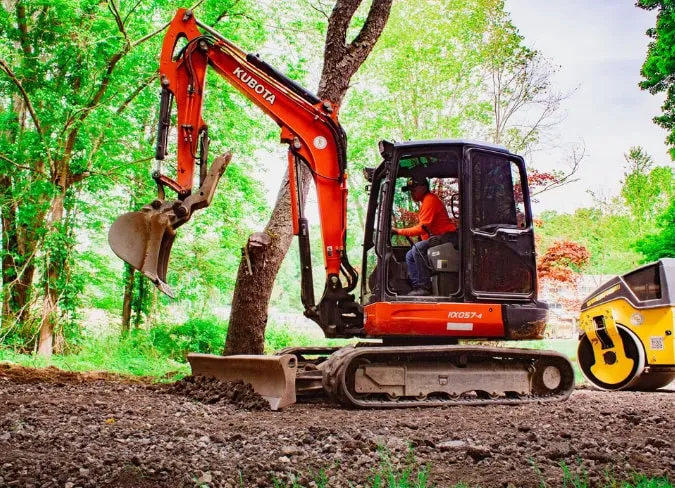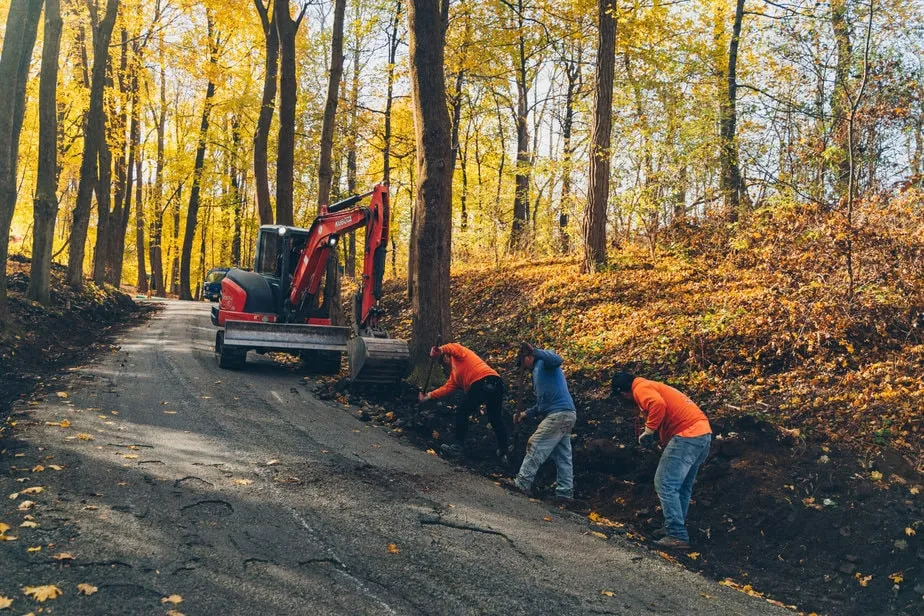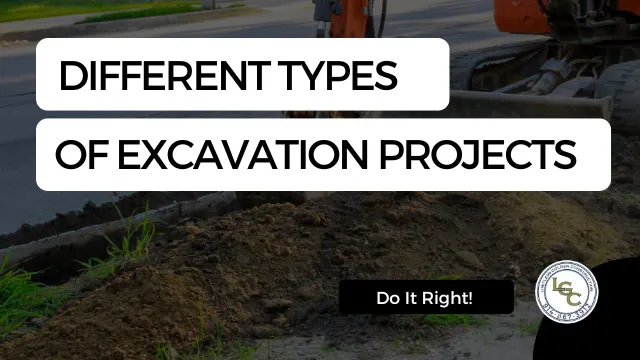There are many types of excavation projects, each designed to meet specific needs and objectives. Understanding the different types of excavation projects is crucial for any construction project. Knowing this ensures employing the right techniques for effective and efficient doing of the task at hand.
Excavation is a foundational part of any construction project. It involves the moving or removal of earth, rock, or other materials in the ground. It plays a pivotal role in paving and drainage services, as well as construction site preparation. This blog post will delve into the different types of excavation projects, their methods, and the equipment used.
Understanding the Different Types of Excavation
When we speak of excavation, we’re referring to several activities — from creating foundations for buildings to digging trenches for utilities. Below, we’ll explore the various types of excavation projects and how they differ from one another.
The primary purpose of excavation is to create a solid, safe, and stable ground for construction. This typically involves earth moving, which is the process of removing, moving, or adding soil or rock. Different types of soil require different excavation techniques and equipment. Which is why understanding the composition of the site is crucial.
There are many types of excavation, each with its own purpose and method. These include:
- Paving Excavation: This involves the removal of soil or rock to prepare for pavement installation.
- Drainage Excavation: This type of excavation is perfect for installation or repairs of drainage systems.
- Trench Excavation: This is typically for laying pipes, cables, or for drainage purposes.
- Foundation Excavation: This involves digging the ground to create a base for building structures.
- Backfilling: This is the process of refilling excavated areas, usually after finishing the construction work.

Expanded Examples of the Different Types of Excavation Projects
1. Paving Excavation
Paving excavation is an initial phase for the construction of roads, sidewalks, or any paved area. It involves the removal of topsoil or unfit material to reach a base that can support the pavement structure. The process ensures the pavement will have a durable, long-lasting foundation.
The difficulty of paving excavation extend beyond merely preparing a surface for paving. It demands a deep understanding of soil types, terrain, and the projected load the pavement will bear over its lifetime. Experts in this field utilize a variety of heavy machinery such as excavators, bulldozers, and graders to ensure the site meets the necessary specifications.
After the excavation and before pavement installation begins, these professionals conduct a series of tests on the excavated surface. This is to confirm its stability and suitability for the intended construction. The quality of this foundational work is necessary, as it directly impacts the longevity and resilience of the paved structure.
For a closer look at the precision and care our team invests in these projects, we invite you to view our gallery. There we showcase a portfolio of our successful paving excavation outcomes.
2. Drainage Excavation
Drainage excavation plays a critical role in managing water flow around construction sites and preventing potential water damage to structures. It carefully designs pathways for water to be efficiently redirected away from construction areas. Therefore, ensuring stability and longevity of the infrastructure. This carefully planned excavation protects properties by preventing flood risks and promoting proper drainage. Proving essential in areas prone to heavy rains or flooding is very important.
If you’re at the planning stage of a construction project and need expert advice on paving, drainage, foundation excavation, or any other type of excavation project, contact us today for a free quote. Don’t compromise on the quality and safety of your construction. Reach out now to take the first step towards a successful project.
3. Trench Excavation
Trench excavation is a specialized type of excavation project that primarily focuses on creating narrow but deep trenches. This is for the installation of pipes, cables, or for drainage systems. This intricate process requires precise digging to ensure the trenches meet specific depth and width requirements. These are crucial for the infrastructure’s efficiency and safety. The complexity of trench excavation is heightened by the need to support the trench walls to prevent collapses. Safeguarding both the workers and the surrounding environment is an important part of the job.
To achieve this, trench excavation teams often employ shoring techniques. Therefore, using materials like wood, metal, or hydraulic supports to secure the trench walls. These measures are necessary to ensure worker safety, comply with regulatory standards, and prevent damage to nearby structures.
Trench excavation, therefore, not only demands skill and careful planning but also a profound understanding of the geological conditions of the excavation site.

4. Foundation Excavation
Foundation excavation involves the removal of soil to create the footprint of a building. This type of excavation varies greatly depending on the size and type of foundation. Foundation excavation ranges from shallow (for slab-on-grade foundations) to deep (for basements or underground facilities).
The benefits of creating a careful foundation excavation are many. Firstly, it ensures the long-term stability and safety of the structure. It does this by providing a solid base that can withstand natural shifts in the ground and other environmental factors. This is crucial in areas prone to earthquakes, flooding, or where the soil composition is inherently unstable.
Additionally, a well-executed foundation excavation can prevent future structural issues. Including cracking, uneven settling, or water damage, thereby saving on costly repairs down the line. It also allows for the installation of underground utilities and infrastructure. This includes water pipes and electrical systems, in a manner that is secure and accessible for maintenance.
Overall, the strategic implementation of foundation excavation is vital for the durability, functionality, and safety of any construction project.
5. Backfilling
Backfilling is the process of replacing or adding soil around a completed foundation or trench to restore the area to its original level or to a specific grade. It often involves compaction to ensure stability and prevent settling or water accumulation.
Backfilling is a step towards finishing an excavation project. Moreover, it is critical activity that ensures the structural integrity of the construction site. It involves careful manipulation and layering of soil to ensure proper compaction and drainage. The backfill material can vary depending on the project requirements. Therefore, materials are selected based on their ability to support and protect the underground structure.
This process is vital in preventing water from pooling around the foundation or trench. Not doing it can lead to structural weaknesses, and in some cases, failure. Through precise execution, backfilling helps in achieving a stable and safe environment. Thus, paving the way for the final stages of construction or for the land to be returned to its intended use.

What are the Specific Considerations and Requirements in the Different Types of Excavation Projects?
Paving excavation requires careful planning and execution. The surface must be properly prepared and leveled. Moreover, the correct depth must be achieved for the pavement to be stable.
Drainage excavation requires knowledge of the site’s water table, soil composition, and local regulations. Proper slope and grade must be established to ensure water will flow away from structures and prevent flooding.
In New York (NY) and Connecticut (CT), specific considerations also include adherence to state and local building codes. These address safety standards, environmental impact, and preservation of the area’s natural landscape. Additionally, in coastal regions of CT, particular attention must be paid to storm surge and flooding potential. Therefore, needing advanced drainage solutions and resilient infrastructure design to withstand these challenges.
What are the Various Types of Excavation Equipment, and How are They Used in Different Projects?
Equipment Essentials for Excavation
Excavation equipment varies based on the type and scale of the project. Commonly used machinery includes excavators, backhoes, bulldozers, and trenchers.
Excavators, with their versatile design, are pivotal in digging, lifting, and moving earth. They are available in various sizes to suit different project scales. Backhoes, combining a front loader and rear excavator, offer flexibility for smaller sites where multiple tasks. Backhoes are great at digging trenches and moving materials as needed. Bulldozers, known for their powerful pushing capabilities, are essential in clearing large areas of soil, rubble, or vegetation. Thus, making them vital for the initial stages of many construction projects.
Trenchers are another indispensable piece of equipment. Specifically designed for creating narrow, deep cuts in the earth – ideal for laying pipes or cables. Their precision and efficiency make them a preferred choice for utility and infrastructure projects.
Prioritize Safety Protocols in Paving and Drainage Excavation Activities
Safety is important in excavation projects. Training on equipment operation, hazard recognition, and emergency procedures is a requirement for workers. Employees must wear personal protective equipment (PPE) at all times.
Furthermore, proper usage of the equipment, alongside safety regulations and operational guidelines, significantly enhances the productivity and safety of the excavation process. Ultimately contributing to the timely and successful completion of construction projects.
Explore Methods and Technologies That Minimize the Ecological Impact of These Excavation Projects
It’s essential to consider the environmental impact of excavation projects. This is minimized through careful planning, using eco-friendly equipment, and implementing erosion control measures.
Its important to keep in mind the need for environmental consciousness in excavation projects in states like New York and Connecticut, where environmental conservation is highly valued. Sustainable practices and the use of green technologies are crucial in preserving the states’ natural landscapes and ensuring the well-being of their ecosystems.
It is crucial to understand the types of excavation projects, their methods, and the equipment used for anyone involved in construction. By following best practices and prioritizing safety and sustainability, we can achieve successful excavation projects with minimal environmental impact.
Start your excavation project today with Limitless Golden Construction. Get a free quote today or contact us to learn more!


